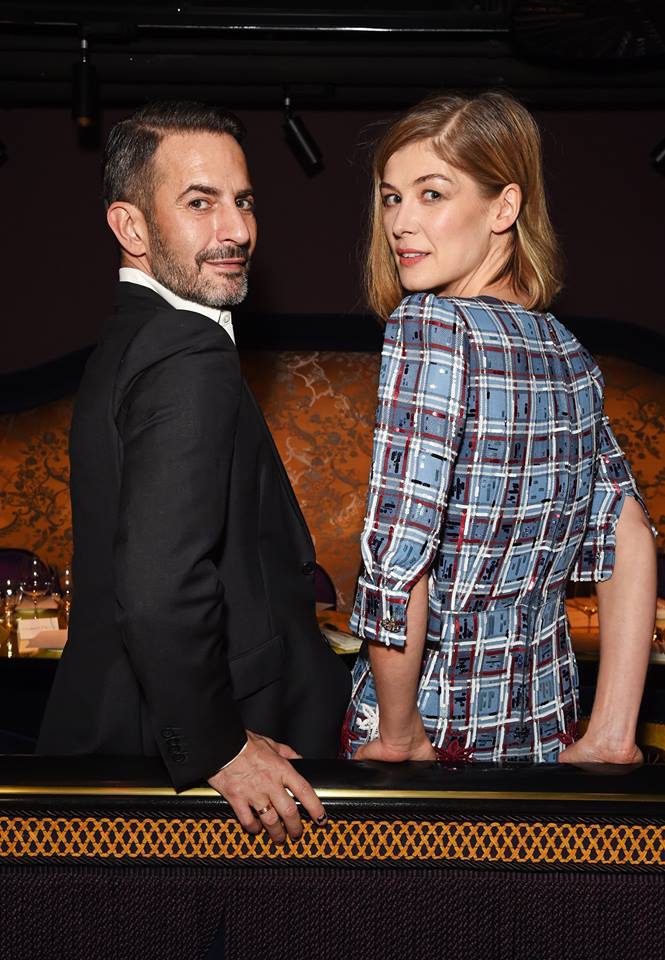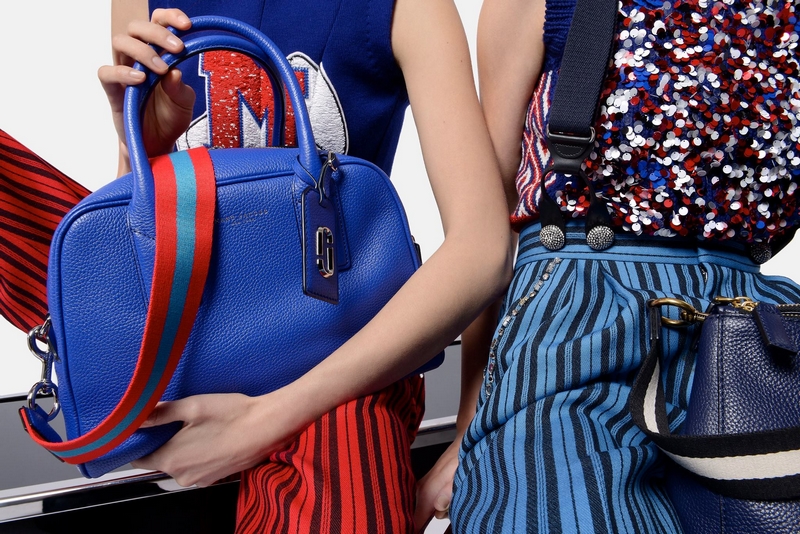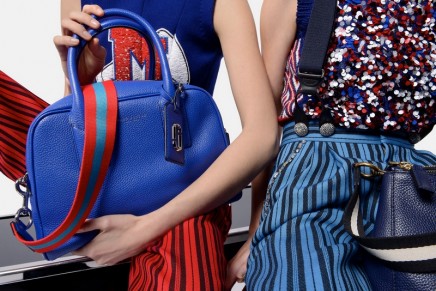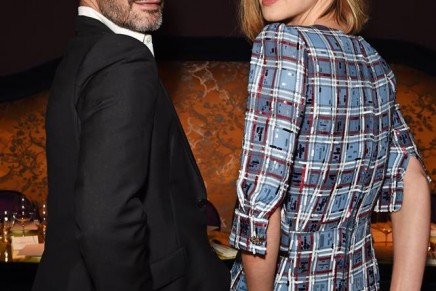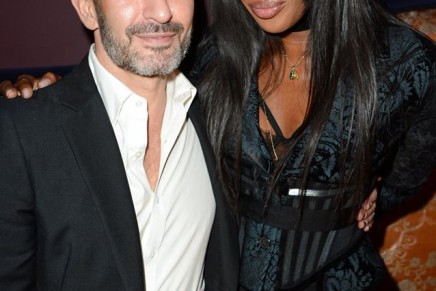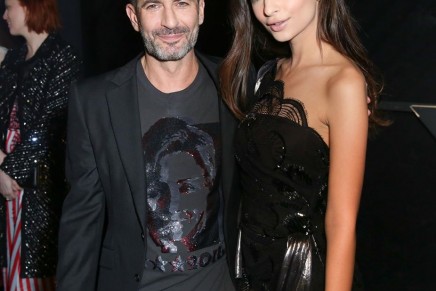“You can ask me anything. I’m an open book. What do you want to know?”
That, right there, is who Marc Jacobs is. Maybe he doesn’t mean it quite literally – what smart, self-respecting 52-year-old is going to share his deepest secrets with a journalist he barely knows? – but the sentiment is heartfelt, no doubt about that. I Want Your Love, Chic’s 1979 disco classic, is playing in his office, seven floors above Spring Street in New York’s SoHo. Jacobs lights a cigarette and leans back in his chair. “I have the word ‘Shameless’ tattooed on my chest. I want to be as honest as I possibly can,” he says. “I sleep better at night.”
Marc Jacobs made his first appearance in American Vogue in 1986, sporting long hair and an oversized black sweater in the back row of a group shot of eight up-and-coming designers. Thirty years later his name remains box office, with the clout to close New York fashion week. But this Marc Jacobs, on the other hand – the joke-sharing, secret-spilling social media personality – is newly minted in the two years since he finished an epic 16-year stint at the helm of Louis Vuitton. He has climbed down from his Parisian ivory tower, settled back into downtown New York and begun a restructuring of his label that puts Marc Jacobs, the man – his face, his values, his sense of humour – front and centre. And in doing so, he has rebooted his persona as one of the most compelling figures in the fashion industry.

Right. So what do I ask him? I want to ask about his spring/summer collection, conceived as a celebration of America’s legalisation of gay marriage. And about his casting of transgender director Lana Wachowski as a campaign model, and the process by which he is engaged, through fashion, with contemporary issues around gender. But I am also dying to be really nosy about what went down on his recent Caribbean holiday, the one from which he posted Zoolander tribute videos and amateur cabaret skits wearing polyester Santa costumes, and was rewarded for his jollity with snipey online noise about whether he was partying when he should be designing. (Jacobs did spells in rehab for alcohol and drug addiction in 1999 and 2007, before getting sober.)
So, naturally, I ask him about the videos. “That was a happy, healthy vacation after working really hard all year. It was actually hilarious, because one day we’re all at the table – I was with Neil [Barrett, fashion designer] and his boyfriend, and Dean and Dan [Caten, designers of Dsquared2] and their boyfriends, and they are all European, so they take the whole month of August off – and there’s this magazine article about Marc Jacobs’ never-ending vacation. And I’m like, what? I’ve had two weeks off this entire year!”
Sober? “Totally. The previous year, I would have had maybe a glass of rosé at lunch. But this Christmas I didn’t drink at all.” The idea for the first video came at “about 11am one morning. We had drunk grapefruit juice and double espressos, eaten brioche and omelettes. We were having fun, which is what being on holiday is about, right? And dressing up, self-expression – that is what fashion is all about. It has nothing to do with being drunk.”

As if to prove his point, the Marc Jacobs I meet is quite different from the one you see in the portrait, taken a couple of hours ago. “I got up this morning and dressed for the photo. I thought, I want to wear a suit, I want to shave and trim, I want to mean business. And then I came into work and 10 minutes later I changed into this, which is what I work in every day.” His office uniform is hi-low athleisure: Marc Jacobs sneakers, white towelling socks, lean Adidas tracksuit bottoms, a snug long-sleeved ribbed T-shirt he calls a “thermal”. It shows off a gym-honed body made, if not for sin any more, then certainly for selfies. The insanely good shape he is in for 52 certainly corroborates a holiday fuelled by nothing more than coffee and omelette. He is refreshingly open about having had a little help with his youthful complexion – his first-ever Instagram selfie was captioned “No filter, (some filler)!” – but his healthy glow looks very real. Only the salt-and-pepper stubble hints at his age, and it suits him. (I guess he knows this, because the silver flecks are on his face but not his head, so if he didn’t like them he could lose the beard.) The one hangover from his misspent youth are the ever-present cigarettes, which he treats like a stage prop. When he is being intense, he presses the manicured fingers of his smoking hand to his forehead, smoke curling above his head, like Marlene Dietrich.
There is something of the character actor about Jacobs, a petite man with six-foot-four charisma. “My relationship with fashion has always been that each of us stars in our own movies and costumes ourselves to play the part we want. You take blouses and jeans and dresses, and you put them together and they tell your story.” This is especially potent for people who feel they don’t fit in, or that the jeans or dress laid out for them doesn’t reflect who they really are. In October 2012, Lana Wachowski, director of the Matrix films, gave an emotional and candid account of her transgender experience in an acceptance speech for the Human Rights Campaign’s Visibility award, in which she spoke of feeling “that I am broken, that there is something wrong with me, that I will never be lovable.” The speech resonated with Jacobs, because, “while I didn’t have that particular experience – I never had any kind of gender confusion – I knew from a very early age that I was gay. And so at nine years old I felt like I was different from the other boys. I didn’t want to play sports or roll in the mud eating worms, or whatever. I wanted to make ceramics and embroider my jeans and go shopping for back-to-school clothes. My parents never, ever taught me that one skin colour was better than another or a particular sexual preference made me normal– and yet when I was with the other kids, I just knew that I was different. That was hard. That’s where I had such a connection to what Lana was saying.” Sandra Bernhard, Bette Midler and drag queen Dan Donigan also feature in this season’s campaign. “Authentic, extraordinary human beings who, at various times in my life, opened my mind,” he says. “And, you know, wouldn’t it be wonderful if we could just all accept each other’s differences?” He throws his arms wide in a Broadway flourish, ever the performer.

Jacobs himself has always been broad-minded about gender in his wardrobe. He wore a kilt to jury duty in 2010 and a black lace dress to the Met Gala two years later. “Lorenzo Martone, who I used to be engaged to be married to, used to tease me about wearing skirts. But I don’t see how there’s anything masculine or feminine about a piece of clothing. If there’s a great Prada coat that fits me, I don’t care if it’s in the women’s department. But things are changing. Lorenzo has evolved, so much, as a human being, that he would never say something like that now.” Despite their split, Jacobs and Martone remain such good friends that Martone and his boyfriend, as well as Jacobs’ boyfriend, were part of the Caribbean holiday gang.
***
Jacobs’ early childhood was chaotic. After his father died when he was seven, his mother remarried several times in quick succession, uprooting the family each time before Jacobs found emotional stability as a teenager, living with his grandmother on the Upper West Side. You get the impression he became worldly at an early age, even for a New Yorker. Last September, Jacobs closed New York fashion week with a love letter to his native city, an exuberant, Broadway-themed show staged in the historic Ziegfeld theatre, entitled Marc Jacobs: One Night Only. It was part nostalgia and part optimism, born out of the emotion of the June day last year when the supreme court ruled same-sex marriage to be a legal right across the US. “We were all elated on that day. We were together for the first meeting about the collection and in a very flip sort of way I said to the design team, we should do Americana, the red, white and blue. And we started talking about America, and about New York, and Katie [Grand, Jacobs’ stylist and collaborator] told me about this documentary where Bette Midler, who is a performer I have loved since I was eight or nine, takes the journalist around all the places of her past in the city. And when I watched it, so much of it was my New York, the city I grew up with. So that became the starting point for the collection.”
But how, I ask, does that translate into fashion? How do you get from the emotional power of the idea of New York City, to clothes in a store? “Because there’s a visual aspect to everything. And to me the visual part is the seductive part. Every colour, every print, every embroidery in that collection references some aspect of my life in New York over the past 40 years.” The show was a knockout, and its autobiographical spirit seemed to symbolise how Jacobs, no longer splitting his time between Marc Jacobs, a diffusion line and Louis Vuitton, was once more putting his heart and soul into Marc Jacobs.

Jacobs is wearing Adidas striped tracksuit bottoms, the polyester kind, and a Cartier “Juste un clou” bracelet, styled after a curved nail, which retails at £34,300. A healthy tension between low-fi and high-flying has been a theme since 1993, when the Grunge collection he designed for Perry Ellis, aged 30, won him the prestigious CFDA Women’s Designer of the Year award, but also got him sacked. Many promising young fashion stars, once knocked off course, are never seen again, but not Jacobs. Within a year he was back on the New York fashion week schedule with his own label, Linda Evangelista and Naomi Campbell walking in the first show for free. In 1997, he was hired by Louis Vuitton, where he turned a luxury luggage company into a fashion powerhouse, while simultaneously expanding the Marc Jacobs empire with the launch of a Marc by Marc Jacobs diffusion line in 2001. In 2013 Jacobs left Louis Vuitton to concentrate on his own line, after which the Marc by Marc Jacobs line enjoyed a feted last hurrah under British designers Luella Bartley and Katie Hillier, and then shuttered. The signs are that the newly streamlined Marc Jacobs company – majority owned by LVMH, with Jacobs and longtime business partner Robert Duffy each retaining a stake – is headed for a stock market launch. (In 2013, a timescale of three years was mooted, but no date has yet been set.) Duffy has stepped aside from CEO duties, replaced by Sebastian Suhl, fresh from overseeing a period of expansion at Givenchy, and today Jacobs is enthusiastic about pouring his energies into a new, potentially lucrative Marc Jacobs beauty line. “I love cosmetics,” he says. “It’s like a show: choosing the colours, the image, the shapes and forms with the packaging, the names.”

Jacobs’ first Marc Jacobs show after leaving Louis Vuitton was a homage to the veteran Vogue editor Diana Vreeland. At the time, Jacobs was quoted in Vogue saying, “I am so appalled by the whole social media thing. I don’t get it, it doesn’t appeal to me.” I spoke to Jacobs backstage after that show, and wrote in my notebook that he spoke of Vreeland as “passionate in her tastes, but never afraid to totally change her mind” – words that seemed prophetic a month later, when Jacobs embraced Instagram with zeal. He laughs about this, when I ask him. “When I said that about social media, I was on a bit of a tirade. Four blocks of the West Village were shut off that day because of the crowds to meet Kendall Jenner, and it just seemed insane. I was very into Vreeland at that time, and her thing of being very absolute yet very arbitrary in her tastes. She absolutely loved something right up until the point where she absolutely hated it.” The day he read his quotes in Vogue, he went home and took a selfie. “And that was how my Instagram account was born.”
He now has 400,000 followers. “I like the attention,” he says, disarmingly. “I like reading the comments. Well, most of them. Of course the problem is that there can be 500 positive comments, but the one negative comment will be the one that I remember and the one I talk to you about. I talk to my therapist about this all the time.”
The dynamic goes like this: I ask Jacobs questions about fashion, which he answers by talking about people and relationships and conversations, rather than about clothes. Ask him about red carpet fashion and he talks about how much he loves Cher, whom he dressed for the Met Gala last year. Ask him about the Americana collection and he talks about his memories of clubbing in the meatpacking district before gentrification. Ask him about the ad campaign and he talks about how he and his boyfriend cried when they listened to Lana Wachowski’s speech. He is good at chat, the type who can make a taped mid-afternoon workplace interview feel like an after-hours catchup. Even his personal extravagances seem centred around relationships rather than aesthetics: when I admire the Cartier bracelet, he tells me how he bought plain gold versions for each of the friends he went on holiday with. A generous gesture, because Cartier bracelets, even the ones without diamonds, aren’t cheap, and he ran through the holiday guest list at one point and I am pretty sure it ran into double figures. And it’s the same later on, when he tells me about his art collection. It’s about creating a dialogue in a room, he says, about filling a space with ideas and emotions. One of his favourite pieces, he says, is “a 1960s Ellsworth Kelly. It’s a yellow curve on a white canvas, which I’ve imbued with these warm feelings, like a beautiful sunny smile. Really, it’s just a yellow shape. But I feel like it tells a story.
guardian.co.uk © Guardian News & Media Limited 2010
Published via the Guardian News Feed plugin for WordPress.

